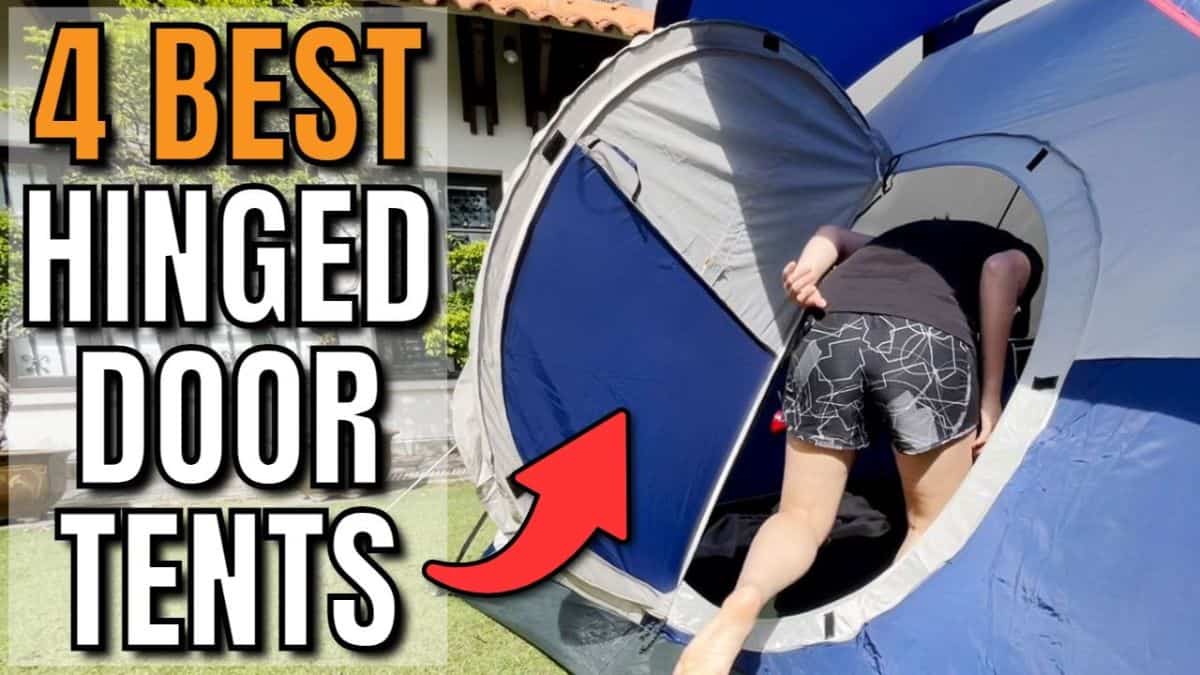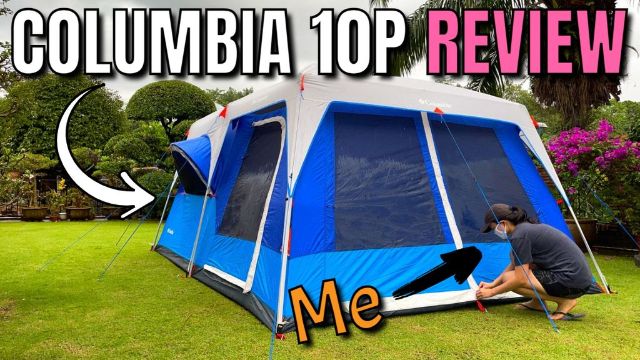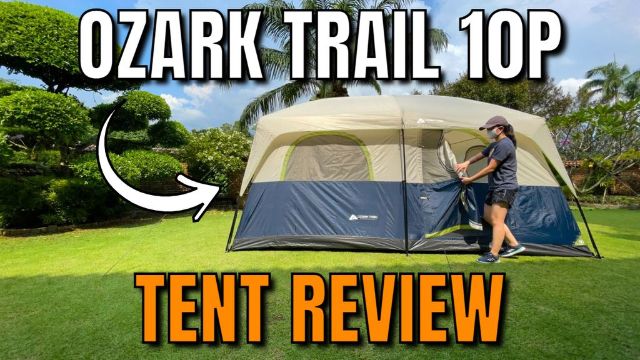I Tested the Coleman WeatherMaster 10-Person Tent (Review)
This page contains affiliate links, and that means that I may earn a commission if you buy something, at no extra cost to you. You can find my full disclosure policy here.
Rating and Summary
I’ve had the Coleman WeatherMaster 10-Person Tent for about 3 years now, and it’s still in great condition. On top of that, the WeatherMaster Tent has tons of great features, like a hinged D-door, and 2 angled windows, and is really quite inexpensive.
The cons aren’t big issues to me, but I do wish that they made the windows a bit bigger for more ventilation, and also seam taped the seams (instead of making them inverted).
Overall, I found the WeatherMaster 10-Person Tent incredible value for money, and I highly recommend it. If you need more details, this blog post will tell you everything you need to know.
If you enjoyed the video, please consider subscribing to my YouTube channel right here:
Check out the WeatherMaster 10-Person Tent:
Product Details
Here’s what we’ll discuss here:
- In the Box
- Specifications
In the Box
I bought this WeatherMaster 10-Person Tent from Amazon, and got the:
- Tent body,
- Rainfly (with pre-attached guylines),
- Fiberglass poles in a carry case (for the angled windows and hinged D-door),
- Steel poles in a carry case (for the main tent body),
- Steel and plastic stakes in a carry case, and
- Room divider.


Specifications
Here’s all the data (including my personal measurements) that I gathered on this WeatherMaster 10-Person Tent:
- Peak height: 80.5 inches
- Lowest height: 58 inches
- Longest Length: 16 feet 8 inches
- Longest Width: 9 feet 1 inch
- Base Area: 143.6 square feet
- Floor material: Polyethylene
- Bathtub Flooring: 7.5 inches
- Tent body material: 68D Polyester
- Rainfly material: 75D Polyester Taffeta (450mm)
- Poles material: Steel (roof and walls), fiberglass (D-door and angled windows)
- Packed size: 31 by 18 by 12 inches
- Weight: 30.6 pounds
- Number of guylines: 6
- Number of stakes: 16 (10 metal, 6 plastic)
- Number of windows: 4
- Number of doors: 2 (one is hinged)
- Number of vents: None
- Number of pockets: 4
- Number of gear lofts: None
- Number of lantern loops: 1
- Room divider: Yes (1)
- E-port: Yes (1)
- Black-out: No
I also did some testing on my own, and came up with this data:
- Set up timing (2 people): 10 minutes
- Set up timing (1 person): 19 minutes
- Take down timing (2 people): 8.5 minutes
- Take down timing (1 person): 16 minutes
- Number of single sleeping pads: 10
- Number of queen-sized mattresses: 3
I go through all the above specifications in the sections below, in more detail, if you’re interested.
Testing and Performance
I put the Coleman WeatherMaster 10-Person Tent through these 7 tests:
- Ease of Use
- Spaciousness
- Comfort & Features
- Ventilation
- Rain Protection
- Quality
- Portability
Here’s how the WeatherMaster 10-Person Tent performed.
Ease of Use
For ease of use, I looked at how easily I could put up, as well as take down and pack up, this WeatherMaster 10-Person Tent. I did this on my own, so 1 person, and also, I tested this with 2 people as well.
How to Set Up
To set up this WeatherMaster 10-Person Tent, assemble all the steel poles. 3 will be slightly curved, and the other 6 will be mostly straight with a bend at one end.

Next, insert the 3 slightly curved steel poles (in the red box in the picture above) into the 3 pole sleeves across the width of the tent.
One of these curved poles will have a red band or ring, and this is to go into the middle, red-colored pole sleeve.
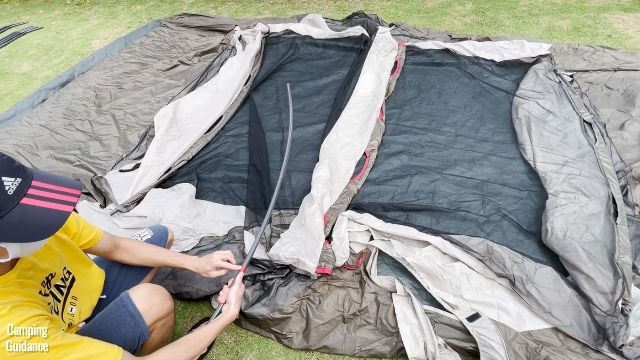
Then, attach the 6 straight steel poles to the 3 slightly curved steel poles. 2 of them will have the red band as well, and these 2 poles are to be attached to both ends of the curved pole (that is already inside the red pole sleeve), like so:

When you’re done attaching all the steel poles, your WeatherMaster 10-Person tent should look like this:

After, stand all the poles up without attaching them to the tent base yet.
Once all the poles have been put up vertically, it’s much easier to insert the bottom of each pole into this Coleman pin at the base of the tent.
Tip: I usually do the 2 poles at the sides first, followed by the middle or center pole.

Next, assemble all the fiberglass poles.
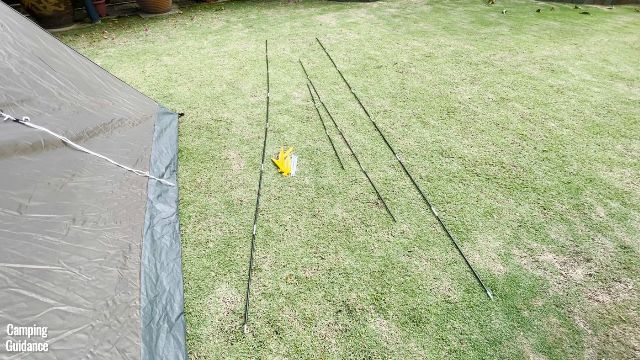
The 2 shortest fiberglass poles are for the hinged D-door. Insert the shortest pole (with 3 fiberglass segments) into the short pole sleeve on the left of the D-door.
Insert the next shortest fiberglass pole (with 5 fiberglass segments) through the curved pole sleeve of the D-door, like so:

Gently bend the fiberglass pole while zipping up the pole sleeve. To secure each fiberglass pole in place for the D-door, there are rubber gaskets to attach it to (both top and bottom, pictured later under “Quality”).
The other 2 longest fiberglass poles (with 7 fiberglass segments) are for the angled windows at the left and right width of the WeatherMaster tent. To secure each fiberglass pole in place, there will be a small hole to insert the pole into, which you can find on the nearest steel pole.

Then, attach all the pole clips to the nearest steel pole.
After, grab the rainfly, drape it over the tent.
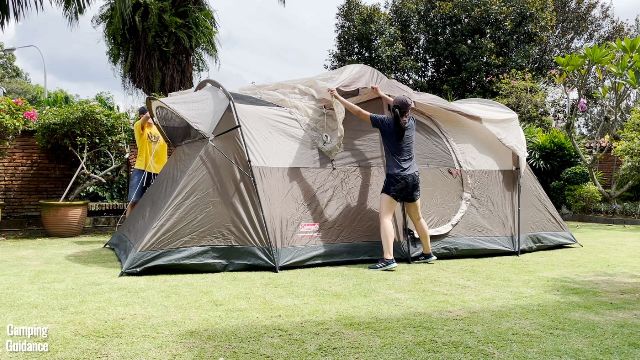
Make sure to secure the rainfly properly over the angled window at each end of the tent, and then attach the S-hooks of the rainfly to these holes in the nearest steel pole:

There are also Velcro attachments to secure under the rainfly, 1 at each middle pole, and 2 at each side pole:

Finally, stake out the tent. There are 10 standard steel stakes for the base of the tent, and 6 of these yellow stakes for the 6 guylines around the tent.

Set Up Timing
It’ll take about ~10 minutes for 2 people to set up this Coleman WeatherMaster 10-Person Tent.
When I put the WeatherMaster 10-Person tent up on my own, it took me about ~19 minutes. I’m only about 5 foot 3, and I was able to set up the entire tent, including the rainfly and the hinged door on my own, with no issues at all.
How to Take Down
Taking down the Coleman WeatherMaster 10-Person Tent is the exact reverse process of the set up (explained above).
I usually then fold the tent body in half 4 times, roll it up, then fold the rainfly in half 5 times, and stuff everything back into the carry bag. It’s quite a tight fit though, so I recommend getting someone to help you with this:
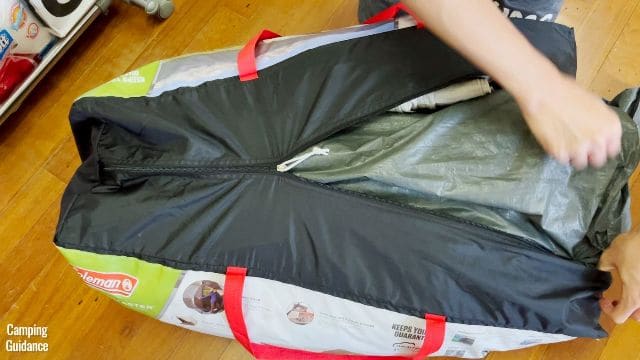
Take Down Timing
Taking down and packing up the WeatherMaster 10-Person Tent takes about ~8.5 minutes for 2 people, and about ~16 minutes on my own, (excluding washing and drying).
If you want more detailed instructions on how to set up, take down, and pack up this WeatherMaster 10-Person Tent, check out this video that I uploaded, right here:
Spaciousness
For spaciousness, I looked at the peak height, slope of the walls, and base area.
Peak Height
This WeatherMaster 10-Person Tent has a peak height of 80.5 inches, and I can reach the top of the tent if I stretch my arm out and stand on tiptoes at the same time.

Slope of Walls
The side walls of this WeatherMaster 10-Person Tent are not really that vertical, especially at this small triangular space here on the widths of the tent:

Here’s what the small triangular space looks like from the inside:

But excluding this space, the lowest height in the tent, which is at the corners of the tent, is about 58 inches. I’m 5 foot 3, so I could not stand upright at the corners, but everywhere else in this tent was fine for me.
Dimensions
The longest length of this WeatherMaster 10-Person Tent is about 16 feet and 8 inches, while the longest width is about 9 feet and 1 inch.

But just bear in mind that the base area in this WeatherMaster 10-Person Tent isn’t like a nice rectangular shape.

FYI, the shortest width of the WeatherMaster 10-Person Tent, right at the edge, is ~7 feet and 1 inch. So, I did the calculations to find out the total base area of the WeatherMaster 10-Person Tent, which is 143.6 square feet.
Mattress Sizing
So, that’s why the maximum number of queen-sized camping mattresses I could fit into this WeatherMaster 10-Person Tent was only 3. Here’s what the tent looks like with these 3 queen mattresses.

The mattresses that I used in this tent are slightly smaller than queen size, but almost queen sized (give or take a few inches). Apart from these 3 mattresses, there’s quite a bit of space leftover for camping gear.
Instead of 3 queen-sized mattresses, you can also fit 10 single sleeping pads or sleeping bags, and here’s what having 10 pads in this WeatherMaster 10-person tent looks like:
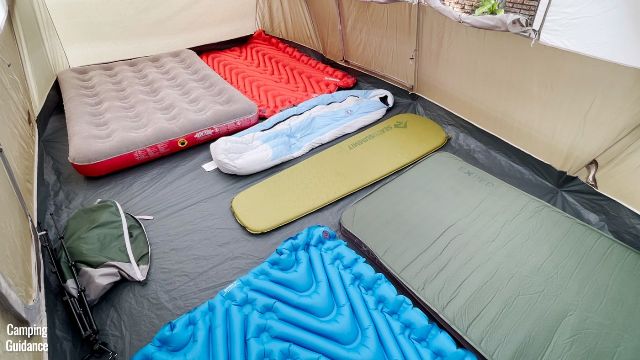
To accommodate 10 people in this tent, it’s almost shoulder-to-shoulder sleeping, although there’s some space (below my 2 single pads, in the picture above) for a little bit of camping gear.
One more thing, there’s no vestibule, so if you leave your shoes out, it will get wet if it rains.
Comfort and Features
For comfort and features, I looked at the windows, doors, bug nets, and more.
Windows
This Coleman WeatherMaster 10-Person Tent has 6 windows around the entire tent, if you include the window mesh of the 2 doors. Excluding the doors, there’s 4 windows.

The windows on the length of the tent are a bit smaller, each measuring about 30 inches in length by 28.5 inches in width.

The angled windows on each width of the tent measure about 60 inches in length by 17.5 inches in width.

Each window has 2 zippers, which are pretty much snag-free.

If there’s no rain, you can unzip the windows for more ventilation, and there’s a bug net to prevent larger bugs from getting in. The holes are quite large, so I don’t think this is no-see-um mesh:

You can use this small latch to tie the fabric of the windows up, so that it looks neater.

Doors
The WeatherMaster 10-Person Tent has 2 doors, one at each length of the tent. The front door on the front length of the tent is this hinged D-door.

The hinged D-door has a handle on both the outside and the inside.
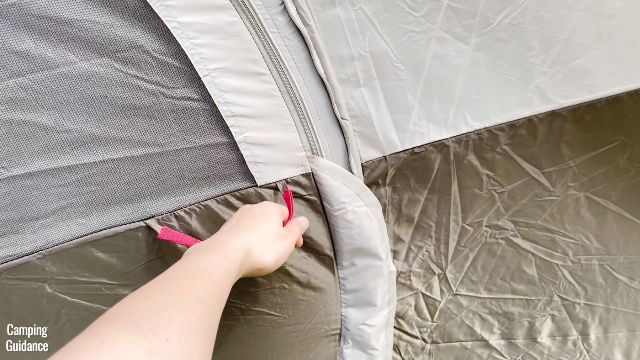
The D-door measures about 47 by 30 inches in dimensions, and is about 59 inches from the ground to the top of the door, so I did have to duck a little when going through the door in and out of the WeatherMaster tent.
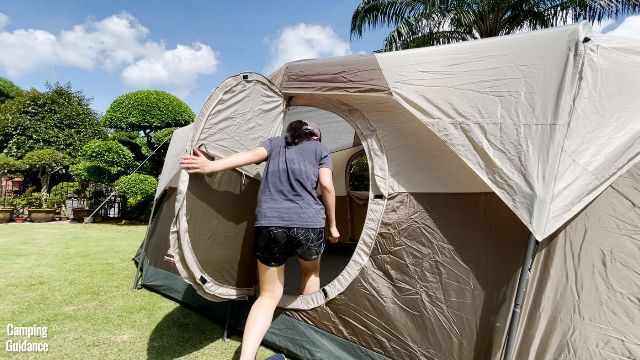
Oh, and here’s what the hinged D-door looks like when I stand in front of it (it’s not very big):
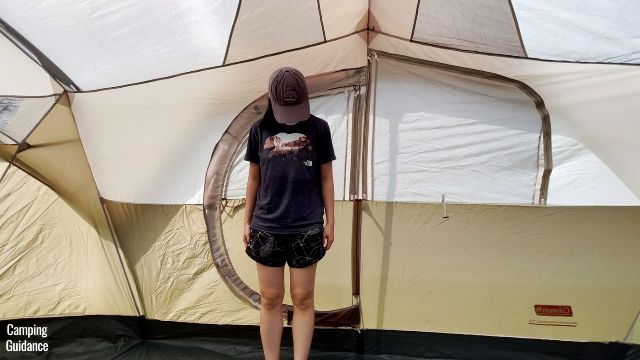
The back door on the back length of the WeatherMaster tent doesn’t come with any fiberglass poles, so it’s not hinged, and you do have to zip it open and close.
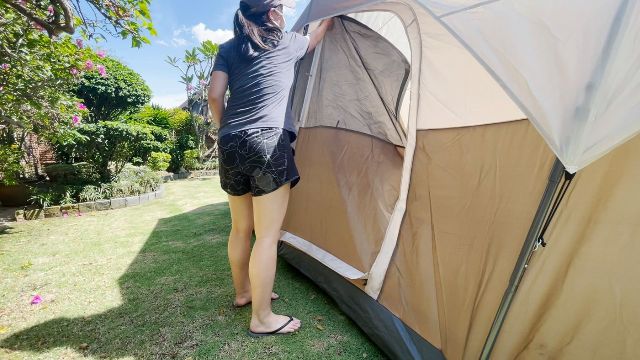
The back door measures about 57 by 34 inches in dimensions. The maximum height from the floor to the top of the door is 65 inches, but it slants downwards (see picture below). So, even at my height of 5’3″, I did have to duck a little when going through the door.

The size of this door’s about twice my size, and here’s what it looks like when I stand in front of it:

Both doors have bug nets, spanning about half the length of each door.

Each door has 2 zippers for the bug net (which is basically the window zipper, pictured above under the “Windows” section), and 2 for the door itself.
The window zippers are white, while the door zippers are black (pictured below):

If there are no bugs, you can increase ventilation by unzipping the back door, rolling it up and clipping it to the side right here like this picture below.
There are 2 of these clips or latches for keeping the door open.

If you need the hinged D-door to stay open, you have to remove the fiberglass poles first. With the fiberglass poles in place, the hinged D-door will not stay open, though you can still zip it up.
If you don’t want to zip the hinged D-door up (Like me! I never zip it up because I’m lazy.), the Velcro attachments around the hinged D-door will keep the door closed.
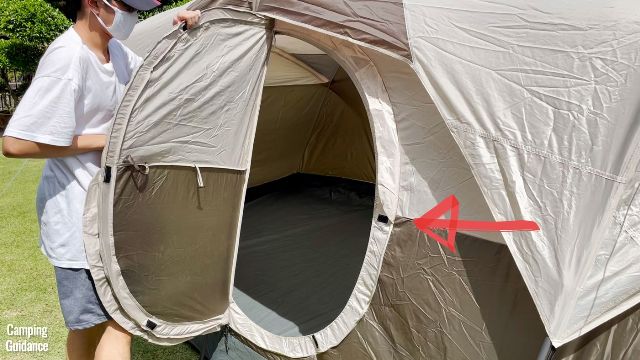
Room Divider
The WeatherMaster 10-Person Tent comes with a removable room divider, so you can split the tent into 2 rooms.
The divider comes with these attachments that you can easily secure to the loops at the sides of the WeatherMaster tent.

Each “room” can then fit either 5 sleeping pads or sleeping bags, or 1 queen-sized bed plus an additional sleeping pad.
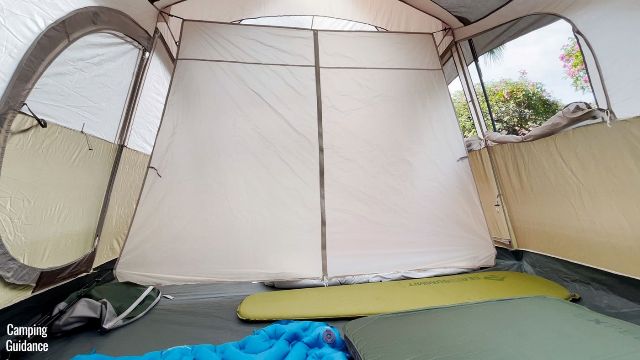
One room, on the left side of the tent, will have one regular window, one angled window, and the back door. The other room, on the right side of the tent, will have one regular window, one angled window, and the hinged D-door.
The divider has a zip in the middle so that you can access either room, and you can also pull back the sides of the divider and clip it to the sides like this for easier access into each room.

You can also fit just 1 queen-sized bed plus 1 sleeping pad in one “room” (see the picture above for this layout), and use the other as a living room, or something else, if you’d like.
What I did not quite like about this divider is that there are pretty big gaps at both sides of the divider, at the top of the divider, and there’s also a gap at the bottom of the divider. I wish it were more full-length.

Storage
There are 4 pockets in the entire WeatherMaster 10-Person tent, 2 on the right of the tent, and 2 on the left of the tent. All the pockets are the same, measuring about 20 by 10 inches in this triangular shape:

Other Features
There’s 1 lantern loop in the tent, at the very top of the WeatherMaster 10-Person tent, right in the center, for some lighting at night.

Also, there’s 1 e-port at the bottom of the tent with a zippered closure.

Ventilation
For ventilation, I looked at how much mesh the WeatherMaster 10-Person Tent has. After all, more mesh means more ventilation.
Ceiling Mesh
This WeatherMaster 10-Person Tent has a lot of mesh on the roof of the tent.

The rainfly is removable, but only from the outside. I really like removing the rainfly during hot days for more ventilation. I could also stargaze at night when it’s not raining.
Window + Door Mesh
Apart from the roof though, the 2 doors and 4 windows are not exactly that big, unfortunately.

That’s why I enjoy removing the rainfly for more ventilation.
Rainy Day Options
But thankfully, 2 of the windows are these impressive angled windows, which I was able to leave open even in the rain. And not just light rain, but moderate to heavy rain as well.

There are no vents in this WeatherMaster 10-Person Tent, so it was good to have some ventilation through the 2 angled windows, and also from the gap between the rainfly and the ceiling mesh.
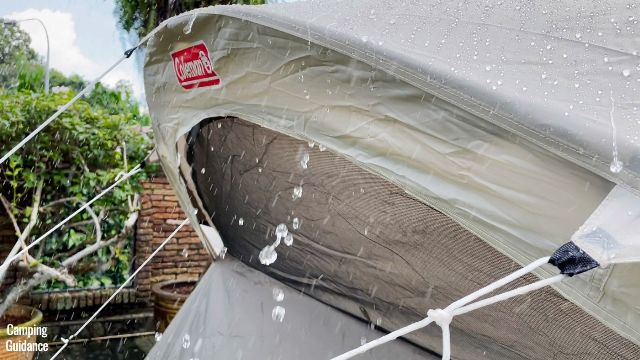
If there’s lots of wind though, and rain gets in through the angled windows (which didn’t happen for me), you can zip them close.
The other non-angled windows and doors have to be closed though, because otherwise, some water will get on the mesh of the windows and doors, especially when there’s wind.
That’s because the rainfly is quite small (which is to prevent water from seeping in through the ceiling mesh):

Weather Protection
For weather resistance, I looked at rain and wind protection. (And yes, I actually rain-tested my WeatherMaster 10-Person Tent!)

Rain Test
It did not rain while I was filming this WeatherMaster 10-Person Tent for my YouTube channel, so I had to make do with this water hose.
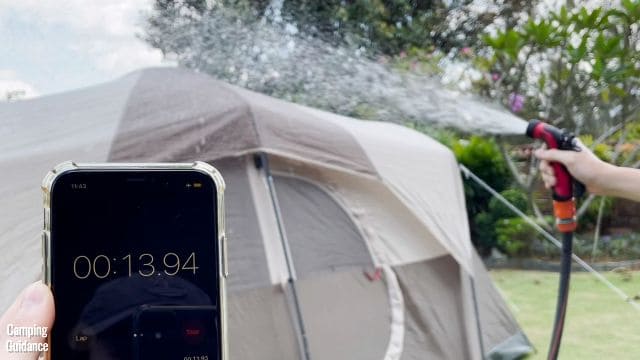
The water hose put the WeatherMaster 10-Person Tent through pretty heavy rainfall, I think. I did this for an hour, and concentrated the rainfall on the front length of the tent.
After about 15 minutes of moderate (arguably heavy) rain on the front of the tent, I noticed that water started leaking into the WeatherMaster 10-Person Tent through this seam connecting the dark brown fabric of the tent body to the bathtub flooring:

This is an inverted seam, but it has not been seam taped.
Actually, every single seam in this WeatherMaster 10-Person Tent is an inverted seam, so none of them were seam-taped. But I didn’t notice any leaking through most of them, except the one seam above.

That’s probably because that seam was exposed to the most amount of water during the rain test.
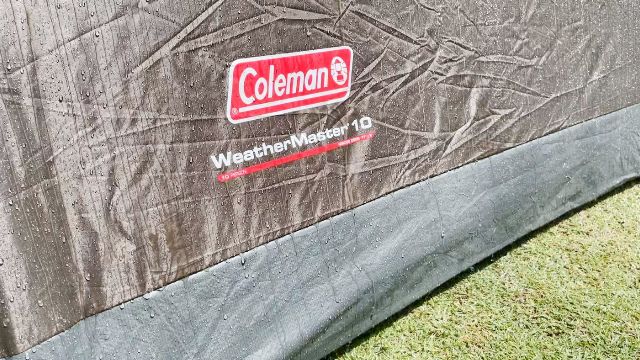
When the 1-hour rain test was up, most of the tent body was still dry. However, the darker brown fabric was slightly damp after being exposed to an hour of this moderate to heavy rain.
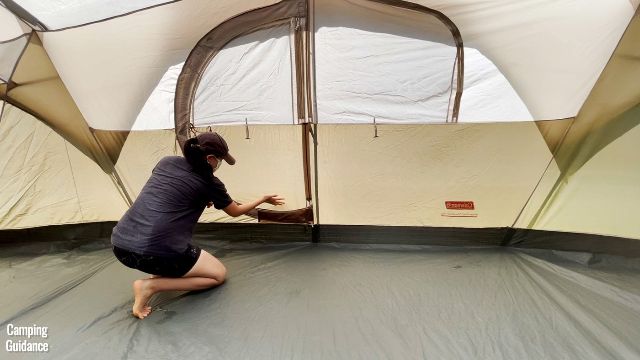
In 1-hour of light rainfall though, the darker brown fabric was still dry, though I did notice that the inverted seam of the bathtub flooring was leaking a little bit.
Tip: So basically, if you’re expecting any rain at all, even light rain, you’d need to seal this inverted seam here.

To check out the overall damage after the rain test, you can watch my short rain test video that I uploaded, right here:
Wind Protection
This Coleman WeatherMaster 10-Person Tent has a more aerodynamic shape than cabin tents, but even so it has a high peak height of 80.5 inches, with pretty vertical walls on the front and back length of the tent.

Also, there are only 6 guylines in total for such a large tent. I noticed that it was able to stand up to light winds, as you might have seen from my YouTube video right at the top, but I’m not so sure about moderate to stronger winds.
Quality
For quality, I looked at the flooring, the main tent, stitching, and more.
Flooring
The flooring of this Coleman WeatherMaster 10-Person Tent is made of polyethylene.

The flooring has a bathtub feature, which extends up to about 7.5 inches.
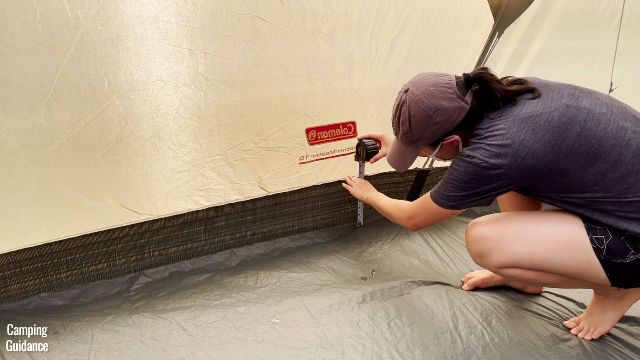
After 1 hour of moderate to heavy rain, I noticed that no water seeped through the bathtub flooring, and it was still dry, which was great.
Tent
The main tent body is made of 68D polyester, and the rainfly is made of 75D polyester taffeta with 450mm of water resistance.

The parts of the tent protected by the rainfly were dry, but the dark brown fabric of the tent body that was exposed to an hour of moderate to heavy rain was a bit damp.

Stitching
All the seams in this WeatherMaster 10-Person Tent are inverted, and I found the stitching to be pretty good quality and consistent even on the doors and windows, with no glaring holes or anything, unlike some of my other tents.

Zippers
The zippers were pretty good quality, and I had no leaking issues through the zips or zippers on the windows and doors.

The windows were pretty much snag-free, and so were the doors from the inside, but the back door will still occasionally snag from the outside because of the rain cover, so I recommend holding the rain cover while zipping the door open or close from the outside.
Mesh
The holes of the mesh are too big to be no-see-um, but there were no holes or excess mesh in this tent at all, so I had no issues at all.

Poles
So, after ~3 years of having this WeatherMaster 10-Person Tent, I noticed that some of the steel poles, the ones with this silver button in the picture below, became a bit stiff to put together.

But I really like how sturdy it feels after it’s been put together.
Also, the fiberglass pole for the curved part of the hinged D-door is quite thin, and because you need to bend it quite a bit, mine cracked after a while.
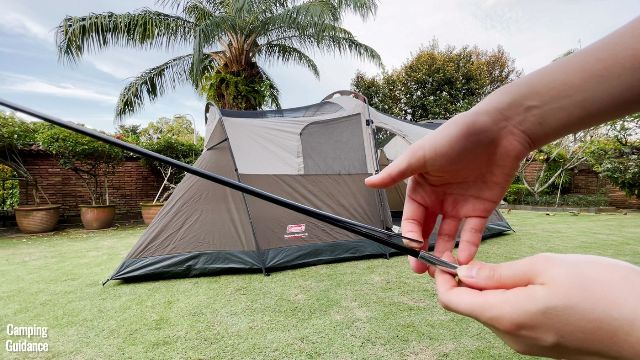
But I quickly just taped it back together using duct tape, and it still works fine.
Also, the tip of the fiberglass pole came out, and got stuck in the rubber gasket, but it still works great anyway.

Guylines
I had no issues with the guylines, though it would be nice if they were reflective at night. But I do really like the guylines of the angled windows here, which keeps it sturdy.

Portability
This WeatherMaster 10-Person Tent has a packed size of 31 by 18 by 12 inches. For a size comparison, here’s what it looks like beside a Coleman 2-Person Sundome Tent, as well as a 32-ounce Nalgene bottle:

The strap is barely long enough to be used as a shoulder strap for me, and it weighs about 30.6 pounds for everything.

Pros and Cons
Pros
For pros, I found the WeatherMaster 10-Person Tent to be good quality and durable. All the seams are inverted, with consistent stitching, the zippers are nice and smooth, and I’ve used this tent over the past 3 years with hardly any issues at all.
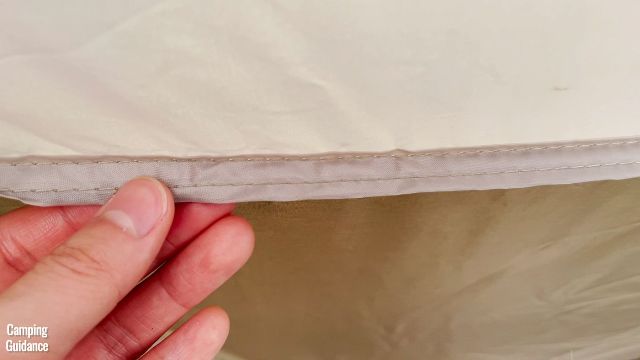
Well, I broke my fiberglass pole, but fixed it quickly with some duct tape.

The next pro is that this WeatherMaster Tent has lots of great features, like the super, super user-friendly hinged D-door, that makes going in and out of the tent a breeze.

It also has these huge angled windows that can be kept open in even moderate to heavy rain, so there’s some ventilation when it’s raining.
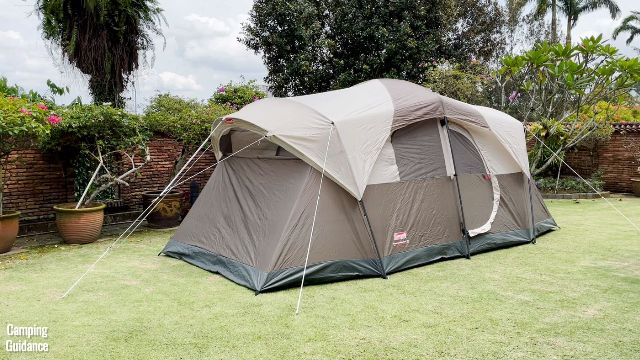
I also really liked that I was able to set up the entire WeatherMaster 10-Person Tent on my own, even though I’m not very tall, the pole sleeves are pretty snag-free (as advertised!), and it didn’t take me very long too.
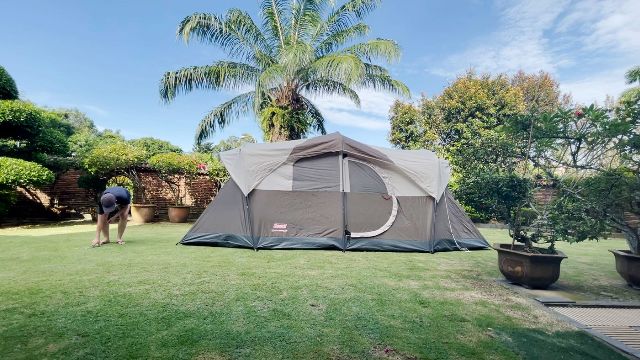
And last but definitely not least, even though this WeatherMaster tent is feature-packed and good quality, I found it pretty inexpensive and it offers great value for money.
Cons
As for cons, I wish they made the non-angled windows a bit bigger for more ventilation during hot days. Right now, they’re not that small, but they’re far from big.

Also, I wish they taped this seam instead of making it inverted, because in my experience, inverted seams don’t really work that well, especially against heavy rain.

Some smaller cons is that the room divider has pretty big gaps at the sides, and Coleman should also have made the carry bag a bit bigger, because now it’s a pretty tight fit to get everything back in.
Recommendation
Overall, I felt that the pros greatly outweighed the cons, and actually if you just seal the leaking seam yourself, there are hardly any cons at all.
This WeatherMaster 10-Person Tent has worked really well for me over the past 3 years, and I got insane value for money out of it, for sure.
Bonus: Must Read!
How does this WeatherMaster 10-Person Tent compare to other similar tents though? Well, don’t worry, because I’ve already done the comparison for you, in this blog post right here, where I bought, tested and compared 6 of the best 10-person tents.

I also pitted the WeatherMaster 10 against 13 other Coleman tents in this blog post right here, where I bought and tested 14 of the best Coleman tents.
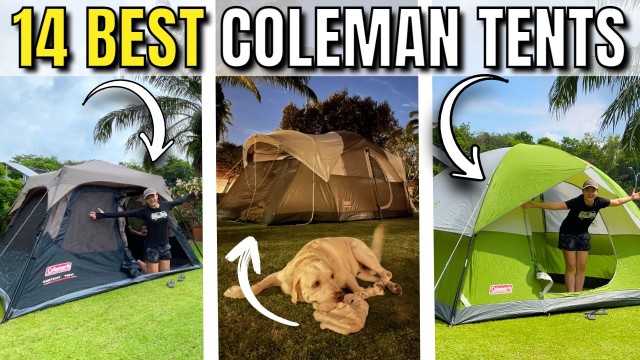
Alternatively, check out this blog post also featuring the WeatherMaster 10: I Bought & Tested the 4 BEST Hinged Door Tents!
To find out how the WeatherMaster 10 compares against the Montana 8, check out this blog post: Coleman WeatherMaster Tent V.S. Montana Tent (I Bought Both!)

Or, check out the WeatherMaster 10-Person Tent:


